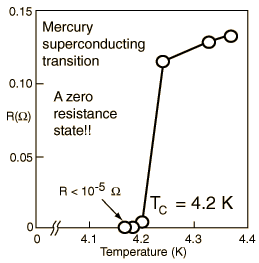Lead as Superconductor
Evidence for zero resistance
Lead is a Type
I superconductor with a critical
temperature of 7.2 K. Although such superconductors can conduct
currents with zero resistance, their usefulness is limited because of low
critical
magnetic fields. Above a certain current, the magnetic
field created by the current drives the material into a normal
resistive state.
If a current is generated in a superconducting lead ring, it will
persist because of the zero resistivity. Currents have been maintained in
lead rings for several years to test the zero resistance condition. An
induced current in an ordinary metal ring would decay rapidly from the
dissipation of ordinary resistance, but superconducting rings had
exhibited a decay constant of over a billion years!
An exactly zero resistance implies a quantum effect - an energy gap. If
the charge carriers do not interact with their environment to reduce their
energy even a little bit, it must be because they can't - they are
forbidden to by conservation of energy. This implies that there are no
available quantum states within reach of the energy they have. The
evidence for an energy gap was one of the steps which led to the BCS
theory of superconductivity. |








